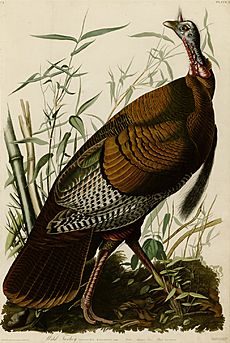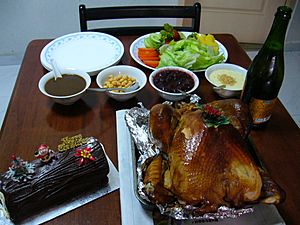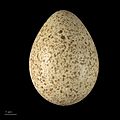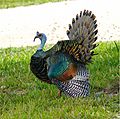Turkey (bird) facts for kids
The turkey is a large bird that belongs to the genus Meleagris. These birds are originally from the Americas. One type, Meleagris gallopavo, is known as the domestic turkey or wild turkey. It lives in the forests of North America, from Mexico up through the central and eastern United States, and into southeastern Canada. The ancient Mayans in Mexico were the first to tame these birds.
The other type of living turkey is Meleagris ocellata, also called the ocellated turkey. This bird lives in the forests of the Yucatán Peninsula. Male turkeys of both types have a special fleshy part called a wattle or a snood. This hangs from the top of their beak. Turkeys are some of the biggest birds in the areas where they live. Just like many other birds in their group (called Galliformes), the male turkey is bigger and much more colorful than the female.
Quick facts for kids Turkey |
|
|---|---|
 |
|
| Wild Turkey, Meleagris gallopavo | |
| Scientific classification | |
| Kingdom: | |
| Phylum: | |
| Class: | |
| Order: | |
| Family: |
Meleagrididae
|
| Genus: |
Meleagris
|
| Species | |
Contents
What is a Turkey?
Turkeys belong to a group of birds called Galliformes. This group also includes pheasants, partridges, and grouse. The genus Meleagris is the only living group of turkeys. It used to be its own family, but now it's part of the larger Phasianidae family, which includes pheasants.
The History of the Turkey's Name
There are two main ideas about how the turkey got its name. One idea is that when Europeans first saw turkeys in America, they thought they were a type of guineafowl. Guineafowl were already being brought into Europe by traders from a region called the Levant, which was part of the Ottoman Empire. These traders were often called "Turkey merchants." So, the guineafowl were nicknamed "Turkey coqs."
When the new bird from North America arrived, people called it "turkey fowl" or "Indian turkeys." This name was then shortened to just "turkeys."
The second idea is that turkeys came to England from the Americas on ships from the Middle East. These birds had been successfully tamed there. Again, the traders who brought them were called "Turkey merchants." So, the birds became known as "Turkey birds" or simply "turkeys."
In 1550, an English sailor named William Strickland brought the turkey to England. He was even given a special symbol for his family, called a coat of arms, that included a turkey. The famous writer William Shakespeare used the word "turkey" in his play Twelfth Night around 1601 or 1602. The way he used the word suggests that everyone already knew what a turkey was.
Different Names for Turkeys Around the World
In many countries, turkeys have different names. Interestingly, many of these names suggest an Indian origin. For example:
- In Arabian countries, it's diiq Hindi, meaning "Indian rooster."
- In French, it's dinde, meaning "from India."
- In Russia, it's indyushka, meaning "bird of India."
- In Poland, it's indyk.
- In Turkey, it's Hindi, meaning "India."
These names might come from the idea that Christopher Columbus thought he had reached India when he arrived in the Americas. In Portuguese, a turkey is called a peru. This name is thought to come from the country Perú.
Some other birds are sometimes called "turkeys" but are not closely related. For example, brushturkeys are different birds, and the "Australian turkey" is actually an Australian bustard. The anhinga is sometimes called a "water turkey" because its tail feathers spread out like a turkey's when it dries them.
A baby turkey is called a "chick," "poult," or "turklette."
Wild Turkeys and People
Wild turkeys can sometimes act aggressively towards humans and pets, especially in neighborhoods where they are used to people. Wild turkeys have a social order, and if they get used to humans, they might treat people like other turkeys. This can lead to them trying to show who's in charge or even attacking people they see as weaker.
Some towns, like Brookline, Massachusetts, suggest that people should act strongly towards turkeys. They recommend taking a step towards the birds and not backing away. Officials also suggest making loud noises, opening an umbrella suddenly, shouting and waving your arms, spraying them with a hose, letting a leashed dog bark at them, or using a broom to push them away.
How Humans Use Turkeys
The Meleagris gallopavo species is raised by humans for its meat. People in Mexico first tamed these birds around 800 BC or even earlier. These tamed turkeys were then either brought to what is now the US Southwest, or people there tamed them independently by 200 BC. At first, they were used for their feathers, which were important in ceremonies and for making clothes and blankets. Native Americans started eating turkeys for meat around AD 1100.
Compared to wild turkeys, domestic turkeys are specially bred to grow much larger for their meat. In America, people often eat turkey on special holidays like Thanksgiving or Christmas.
Images for kids
-
Male ocellated turkey (Meleagris ocellata) with a blue head.
See also
 In Spanish: Pavo para niños
In Spanish: Pavo para niños








